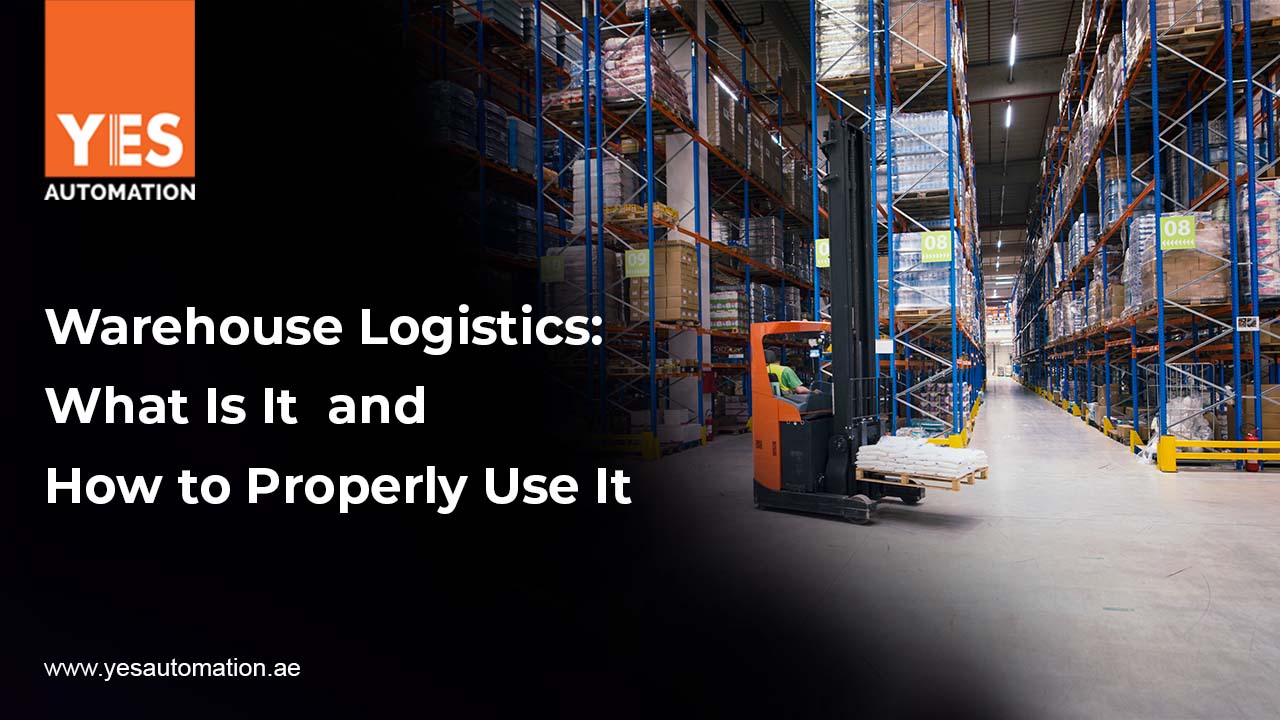Warehouse Logistics: What It Is and How to Properly Use It?

The expansion of e-commerce in 2021 drove up the need for warehouse logistics and compelled the sector to adopt digital technologies. It creates new struggles for warehouse logistics since it demands businesses to specifically handle shipment procedures and manage storage. This blog will highlight the fundamental ideas of the sector, list the primary categories and approaches in warehouse logistics, and highlight how YES Automation can help you make your logistic jobs much easier.
Warehouse Logistics: What Is It?
Logistics and warehousing are frequently combined into one phrase. However, both procedures are just two sides of the same coin. Warehousing is primarily concerned with the storage of commodities and products. Managing, shipping, and delivering these commodities for the end customers is the main function of logistics. Moreover, these procedures need to cooperate to guarantee that the customers receive the goods on schedule and with excellent delivery quality. What is logistics in a warehouse? To begin with, handling storage, planning, arranging, and navigating the delivery procedure is a challenging task. Many digital technologies these days impact logistics and aid in achieving corporate objectives. To assess the supply chain and address business issues, modern warehouse logistics software integrates data science technology with artificial intelligence and machine learning concepts.
Three Primary Warehouse Logistics Types
Warehouse logistics is a complex process that necessitates numerous management and operational functions, as we have already discussed. We will go over each of the three primary categories of warehouse logistics in greater detail later.
Storage Operations
The goal of the strategic, operational work being done at the warehouse is to increase operational efficiency. The management of logistics warehouses strives to keep an eye on employees, plan inventory and training, and foster relationships with shipping firms and other partners. Other duties of warehouse management consist of include:
- Project labor forecasting and management.
- Obtaining a certification and license in logistics.
- Guaranteeing the warehouses' safety protocols.
Addendum to managing warehouse storage space, this kind of logistics also focuses on collecting shipment documents.
How Much Warehouse Logistics Should Cost?
To begin with, the business needs to be well aware of all the rules and regulations and probable expenses. Developing cutting-edge warehouse logistics to meet the demands of all consumers while maintaining supply chains is difficult for the company. A business growth plan that outlines the objectives for the logistics warehousing solution of the future is vital. The organization must examine a few fundamental cost categories to create an accurate budget before planning the warehouse logistics.
- License for software. Permission to use your software may be unlimited, or it may be contingent upon the kinds of warehouses, volume of merchandise, and regularity of logistical processes.
- To accomplish your business objective, you can concentrate on developing custom software or select a ready-made solution. Custom development typically comes at a higher cost. Additionally, the software will save money down the road if it meets all of the needs of the business.
- Hardware or hosting for servers. The price for each option will vary. The program can be stored on a server or in the cloud.
- Reconstruction, Optimization of the logistics warehouse is a continuous process that depends on a number of variables.
Three Primary Warehouse Logistics Types
Warehouse logistics is a complex process that necessitates numerous management functions, as we have already discussed. We will go over each of the three primary categories of warehouse logistics in greater detail later.
Storage Operations
The goal of the strategic, operational work being done at the warehouse is to increase operational efficiency. The management of logistics warehouses strives to keep an eye on employees, plan inventory and training, and foster relationships with shipping firms and other partners. Other duties of warehouse management consist of include:
- Project labor forecasting and management.
- Obtaining a certification and license in logistics.
- Guaranteeing the warehouses' safety protocols.
Addendum to managing warehouse storage space, this kind of logistics also focuses on collecting shipment documents.
Operations of Warehouses
Moving the goods and keeping track of the inventory in the warehouse are the foundations of this procedure. Receiving the goods, arranging them in distinct areas, and sending them to the next destination are the fundamental ideas of this kind of logistics in a warehouse. Successful warehouse functions ensure minimum storage expense, well-timed deliveries, expanded warehouse capacity, and confident customer relations.
Another way to reduce your storage costs is to rent the machines for your operation. Renting machines will not only reduce your storage space as well as customs costs but also give you the latest models at a very affordable price. YES Automation, UAE not also rents you the best latest model machines, but also offers material handling machines like electric tugs that help in easy transportation of your machines.
Systems for Managing Warehouses
A warehouse management system (WMS) is a software program that facilitates real-time process navigation, accurate analytics, and management of all logistical activities. The DevOps process for designing a WMS relies on specific business objectives, but the software will assist in creating a strategic design, managing the process from the UX dashboard, and collecting all the data in relation to warehouse logistics in a single location.
Check out the benefits of glass lifting robots
Warehouse Logistics Solutions: What Are They?
The warehouse logistics systems facilitate supply chain management and actual inventory tracking. We will then highlight the most widely utilized keys for optimizing logistic warehousing.
- Storekeeping
- Inventory controll
- Employing fulfillment companies
- Third-party transportation
This is one option for keeping the inventory for a long time. Businesses using B2B eCommerce orders benefit from it. This logistical option often permits product organizers to store equipment, with lease commitments ranging from short to long term.
The main goals of this system are inventory tracking and product monitoring. Software for inventory management facilitates information analysis and aids in forecasting.
It includes every stage of the logistical process, including inventory control, packing, shipping, and return facilitation. However, a long-time storing issue is not resolved by this technique.
It is not necessary for every business to have its own management system and warehouse logistics software. Sometimes, enhancing the supply chain and using a third-party service would be ideal.
Conclusion On Warehouse Logistics: What It Is and How to Properly Use It?
Businesses looking to enhance their warehouse logistics may find that automation is a blessing in disguise. A number of your warehousing operations can be automated with the use of the right machines and software, which will improve work flow and expedite procedures.. Owning an equipment and at times you will find that renting machines would be the ideal solutions to manage your warehouse logistics properly. In such situations companies like YES Automation where you get the latest models various material handling machines will be your life saver.



